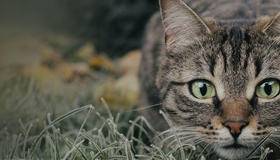
Updated January 16, 2024 – If you’ve ever owned a kitten or visited a shelter, you’ve likely witnessed the sneezing, runny noses and watery eyes typical of feline upper respiratory tract infections (URI). While most of these cat infections are akin to the cold people experience — annoying but not life-threatening — they can occasionally become more serious.
Multiple Organisms are Responsible for Feline Upper Respiratory Infections
For years, veterinarians attributed feline URIs to feline herpesvirus (FHV-1) and feline calicivirus (FCV). While these viruses remain primary culprits, it’s now known that other organisms, either individually or in combination, can also contribute.
The Most Common Organisms Causing Disease Include:
- Feline herpesvirus type 1: A common virus responsible for feline viral rhinotracheitis (FVR), affecting the majority of diagnosed cats. Experts estimate that 97% of all cats are exposed to this virus sometime in their lives, and roughly 80% remain infected, even if the virus does not cause disease.
- Feline calicivirus: Although less common than FHV-1, FCV is a significant cause of URIs and can occasionally lead to lower respiratory tract issues and painful mouth ulcers.
- Feline chlamydia (Chlamydia felis): This bacterium is a more recent addition to the list of organisms that can cause or contribute to URIs in cats. It requires close contact between cats for transmission.
- Feline mycoplasma (Mycoplasma felis): Implicated in both upper and lower respiratory infections in cats.
- Bordetella bronchiseptica: Known for causing kennel cough in dogs, it can also affect cats. A vaccine is available, although it is not considered a core vaccine for cats.
Miscellaneous organisms implicated in URIs in cats include avian influenza, the virus that causes COVID-19, and fungi, usually transmitted from contact with infected people.
Recognizing the Signs of URIs in Cats
While various organisms can cause URIs in cats, the clinical signs are similar, with some more commonly associated with specific organisms than others.
The Most Common Signs Noted Are:
- Sneezing
- Discharge from the eyes
- Red or swollen eyelids
- Runny nose (usually clear)
- Congestion
- Fever
- Loss of appetite
- Lethargy
- Mouth sores
- Coughing
Steps to Take if Your Cat has a URI
URIs are very common in cats, and chances are high that your cat might develop signs in their lifetime. Kittens are most susceptible to infection, but any cat can develop disease if exposed.
A few sniffles and sneezes are not cause for alarm as long as your cat or kitten eats and drinks normally. Mild discharge from the eyes is not an immediate cause for concern. However, if your pet stops eating or drinking and is excessively lethargic, it’s time to see your veterinarian. Likewise, if eye discharge becomes thick and crusty, or you note marked redness and swelling of the eyelids, it’s time to get veterinary care.
Coughing, though rare, warrants veterinary care, as it may indicate the infection is moving into the lower respiratory tract.
The good news is that most upper respiratory infections, especially in older cats, tend to resolve independently without medication or the need for a trip to your veterinary care team.
Preventive Measures
Owners can take several steps to prevent URIs:
- Vaccination: While it doesn’t prevent all infections, vaccination diminishes the severity of signs.
- Indoor living: Keep cats indoors to minimize exposure to infected animals.
- Isolation: Separate infected cats to prevent spread.
- Stress reduction: minimize stress, a significant factor in URIs, especially with feline herpesvirus.
- Regular veterinary checkups: Keep vaccinations up to date and schedule regular well-being checkups.
- Handwashing: Practice frequent handwashing when handling multiple cats
Foundation-funded Studies Take Aim at Prevention and Treatment of URI in Cats
Morris Animal Foundation has supported research on feline upper respiratory infections since 1964, funding 17 studies in the last decade alone. Research has varied from diagnostic tests to reducing stress in shelter cats. Studies have influenced shelter cat housing and improved the treatment of cats with chronic infections.
One of our most exciting active studies is a collaborative effort between the Foundation, EveryCat Health Foundation and the Dumb Friends League, a Denver animal shelter and adoption center.
This study is testing whether the addition of a cat den within a larger kennel can help reduce stress and, in turn, reduce disease incidence in cats housed in a large shelter. The study is in progress and hopes to wrap up in the spring of 2024. If this intervention can curb the disease, it would be a simple and cost-effective way to help the millions of cats housed in shelters and rescues avoid stress-induced health problems, including URIs.
Another study in progress is aiming to develop a better vaccine against FHV-1, FCV and feline panleukopenia virus. The team is using new technology to create the vaccine – we can’t wait to see what they discover!
Our studies focused on feline URIs have informed care of cats in shelters to keep respiratory infections in check, and others have provided the basis for new research on vaccine development.
How You Can Help Cats and Kittens Live their Best Nine Lives
While progress has been made, there’s still much to learn about URIs in cats. Support Morris Animal Foundation’s studies by donating or spreading the word. Learn more about ways you can help kittens and cats live longer, healthier lives.
Resources
- Fresh Scoop podcast Episode 12: Shelter Medicine and Animal Welfare
- Fresh Scoop podcast Episode 14: What Cats Want!
- Fresh Scoop podcast Episode 20: Update on Feline Viruses and COVID-19
- Vaccinations Pros and Cons: Insights for Pet Owners
- Improving the Health of Shelter Pets for Four Decades
- Kitties Gone Viral – Cats & Viruses 101




